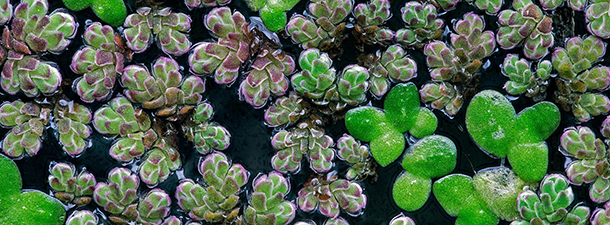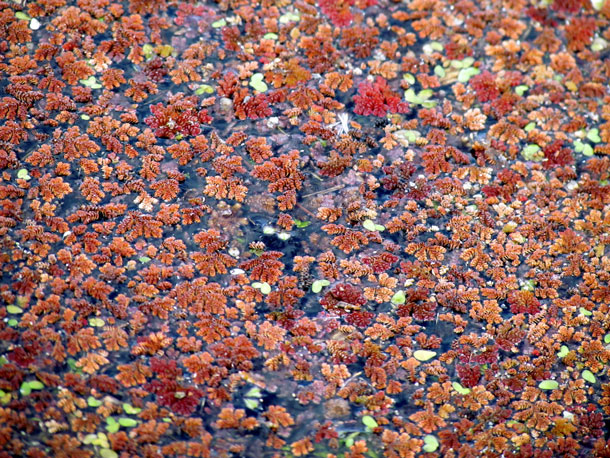Cool Fix For A Hot Planet: A Tiny, Carbon-Sucking Fern
Air Date: Week of October 5, 2018

Azolla is a tiny but fast-growing fern – and a voracious eater of carbon dioxide. (Photo: Richard Droker, Flickr CC BY-NC-ND 2.0)
Fifty million years ago, Earth was a hothouse, with carbon dioxide levels nearly ten times what they are today. Then along came a tiny but fast-growing fern called Azolla. Within a million years it had pulled trillions of tons of carbon dioxide from the atmosphere, cooling the Earth. Living on Earth’s Anna Gibbs explains how the carbon-fixing powers of Azolla might now be harnessed to help us cool the planet once again.
Transcript
CURWOOD: Coming up a failed tsunami warning system has a catastrophic impact in Indonesia but first this cool fix for a hot planet with living on Earth’s Anna Gibbs.
GIBBS: Scientists from Duke and Cornell Universities recently led a crowdfunding effort to sequence the genome of a tiny fern called Azolla. They had a hunch that the ancient plant could help cool down our planet - for a second time.
Fifty million years ago, the earth was hot and thick with greenhouse gases. Carbon dioxide levels were nearly ten times what we see today. Heavy rain flooded the coasts, palm trees sprouted in Antarctica, and the Arctic Ocean was like a warm lake.
Then along came Azolla. It thrived in the nutrient-rich air and soon covered the oceans like a thick green carpet. Though minuscule, with leaves smaller than a gnat, Azolla can double its entire body mass in less than two days. To do that it sucks up a lot of carbon dioxide, which makes it an excellent carbon sink. Within a million years, Azolla pulled trillions of tons of carbon dioxide from the atmosphere. In fact, Azolla gobbled up so much carbon dioxide - nearly half the CO2 available at the time - that it helped cool the planet from an intense hothouse to the temperate climate we have today. Now scientists are researching the potential for Azolla to alter the climate once again.

The Azolla range in color from green to reddish-brown or purple at the edges. (Photo: bobistraveling, Flickr CC BY 2.0)
And if averting catastrophic climate change wasn’t enough, Azolla has another trick up its sleeve: it’s an excellent natural fertilizer. In fact, Azolla has been used to fertilize rice paddies in Asia for over a thousand years, and researchers believe it could be used on other crops to decrease the need for toxic synthetic fertilizers.
And the list doesn’t end there. Azolla has the potential to be a natural insect repellant and even a sustainable food source.
In any case, it seems Azolla may be able to lend us a hand - albeit an extremely tiny one.
That’s this week’s cool fix for a hot planet, I’m Anna Gibbs.
CURWOOD: And if you have an idea for a cool fix for our hot planet please send it our way and we might put it on the air. Our email address is comments at L-O-E dot O-R-G, that’s comments at L-O-E dot ORG.
Links
Yale Environment360 | “Can A Tiny Fern Help Fight Climate Change and Cut Fertilizer Use?”
Living on Earth wants to hear from you!
Living on Earth
62 Calef Highway, Suite 212
Lee, NH 03861
Telephone: 617-287-4121
E-mail: comments@loe.org
Newsletter [Click here]
Donate to Living on Earth!
Living on Earth is an independent media program and relies entirely on contributions from listeners and institutions supporting public service. Please donate now to preserve an independent environmental voice.
NewsletterLiving on Earth offers a weekly delivery of the show's rundown to your mailbox. Sign up for our newsletter today!
 Sailors For The Sea: Be the change you want to sea.
Sailors For The Sea: Be the change you want to sea.
 The Grantham Foundation for the Protection of the Environment: Committed to protecting and improving the health of the global environment.
The Grantham Foundation for the Protection of the Environment: Committed to protecting and improving the health of the global environment.
 Contribute to Living on Earth and receive, as our gift to you, an archival print of one of Mark Seth Lender's extraordinary wildlife photographs. Follow the link to see Mark's current collection of photographs.
Contribute to Living on Earth and receive, as our gift to you, an archival print of one of Mark Seth Lender's extraordinary wildlife photographs. Follow the link to see Mark's current collection of photographs.
 Buy a signed copy of Mark Seth Lender's book Smeagull the Seagull & support Living on Earth
Buy a signed copy of Mark Seth Lender's book Smeagull the Seagull & support Living on Earth

